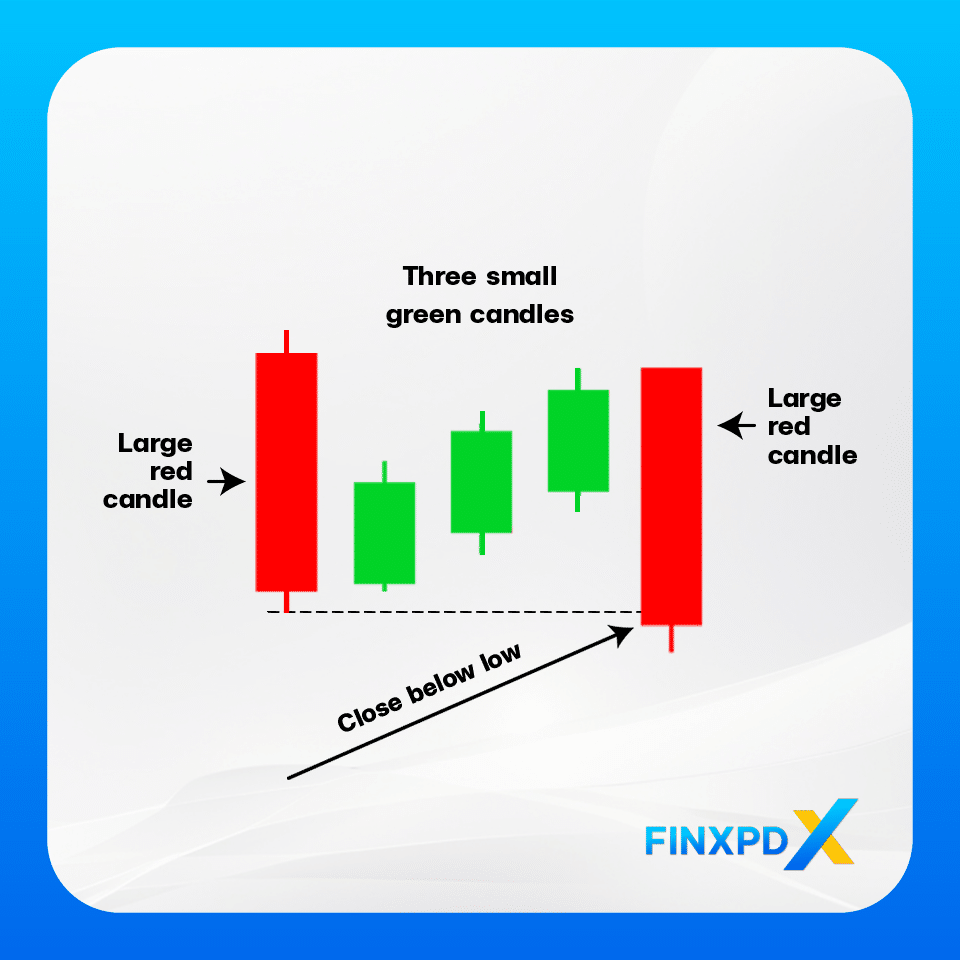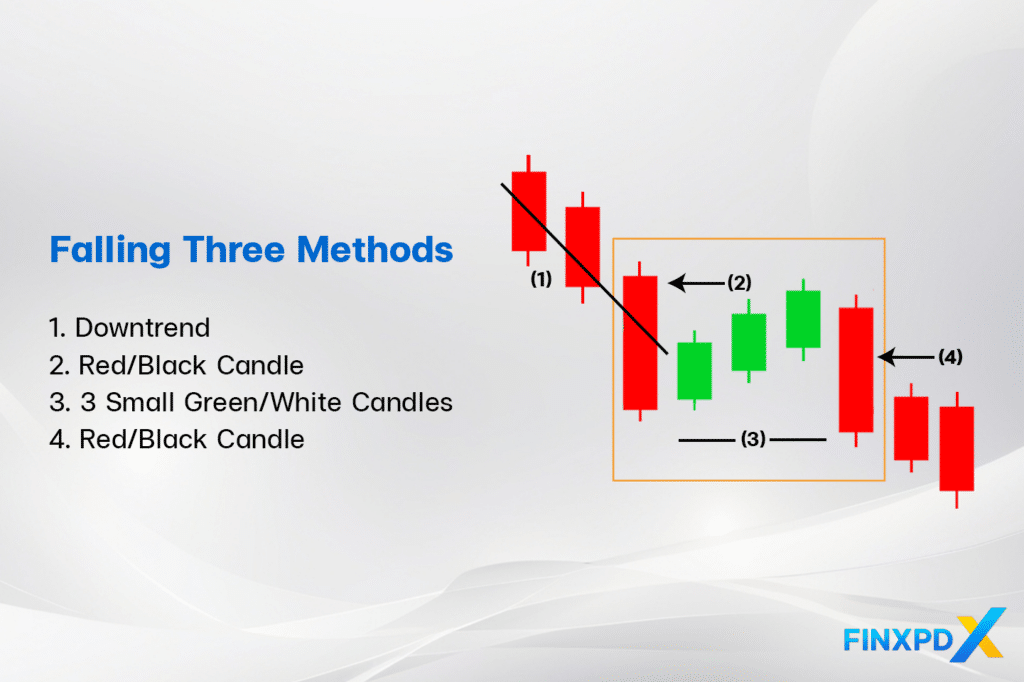Understanding the pattern of the three falling methods is crucial for anyone looking to enhance their trading strategies and make informed decisions in volatile markets. Among several candlestick patterns, the falling three methods stand out as a reliable continuation pattern, particularly in a downtrend.
This article aims to explore the meaning of the falling three-methods pattern, how to identify it, and the psychology behind it. Additionally, we’ll introduce other important triple candlestick patterns that traders should be aware of.
What Is Falling Three Methods?
The falling three methods pattern is a bearish continuation candlestick pattern that signals the continuation of a downtrend in financial markets. The pattern typically consists of five candles, where the first candle is a strong bearish (downward) candle, followed by three smaller bullish (upward) candles, and concludes with another strong bearish candle.
The opposite of the pattern of falling three methods is the pattern of rising three methods. While the falling three methods signal a downtrend continuation, the rising three methods is a bullish continuation pattern that indicates the likelihood of an ongoing uptrend.
Key Takeaways
- The falling three methods candlestick pattern is a bearish continuation candlestick pattern used in technical analysis.
- The falling three methods candlestick pattern shows that sellers maintain control even after a temporary push by buyers.
- The falling three methods consist of five candlesticks, including a large bearish candle, three small bullish candles, and another large bearish candle.
- The three small bullish candles within the falling three methods pattern represent temporary market consolidation.
- The falling three methods is used to confirm a bearish trend, while the rising three methods is used to confirm a bullish trend.
Structure of the Falling Three Methods Pattern

First Candle: Strong Bearish Candle
The pattern begins with a long bearish candle. This candle typically has a large body, reflecting a significant downward move, and establishes the beginning momentum of the downtrend.
Middle Candles: Three Small Bullish Candles
The next three candles are smaller and usually bullish or neutral. These candles stay within the range of the first bearish candle, indicating a temporary pause in selling pressure. However, they do not have enough strength to reverse the trend.
Final Candle: Strong Bearish Candle
The pattern concludes with a large bearish candle that closes below the first candle’s low. This final candle confirms the continuation of the downtrend, showing that sellers have regained control and the downward momentum will continue.
Identify the Falling Three Methods on a Chart

To confirm that a downturn is continuing, you should be able to identify the falling three methods pattern on a chart. Here’s an extensive technique to assist you in quickly recognizing this pattern:
1. Look for an Existing Downtrend
Ensure the market is already in a clear downtrend before the pattern forms, as the falling three methods confirm the continuation of this downward momentum.
2. Look for a Strong Bearish Candle
Ensure the pattern starts with a long bearish candle, indicating strong selling pressure and setting the stage for the pattern.
3. Find Three Small Bullish Candles
Identify three smaller bullish or neutral candles that stay within the range of the first bearish candle, showing a temporary pause in the downtrend.
4. Look for a Final Strong Bearish Candle
Confirm a second long bearish candle that closes below the first candle’s low, signaling the continuation of the downtrend.
5. Confirm the Pattern
Ensure the pattern appears after an established downtrend, with increased volume during the first and final bearish candles to validate the pattern.
The Psychology Behind the Falling Three Methods
The falling three methods pattern highlights the struggle between bearish and bullish forces, offering insight into market sentiment during a downtrend.
Initial Bearish Control
The pattern begins with a strong bearish candle, indicating that sellers are dominating the market and driving prices lower. This establishes a bearish sentiment, suggesting that the downtrend will continue.
Temporary Buyer Effort
The following three smaller bullish candles indicate a brief pause as buyers attempt to increase prices. However, their efforts are weak compared to the beginning selling pressure, showing hesitation and a lack of confidence in reversing the trend. This indicates that while there is some buying interest, it is not strong enough to alter the overall market direction.
Resumption of the Downtrend
The final strong bearish candle confirms that sellers have regained control, reinforcing the downtrend. This candle shows that the brief bullish was a temporary pause, with the market rejecting the buying attempts and resuming its downward momentum, reflecting a strong bearish sentiment.
Other Triple Candlestick Patterns Aside From Falling Three Methods
Besides the falling three methods candlestick pattern, traders should also be familiar with three other related triple candlestick patterns.
Rising Three Methods
- Structure: The rising three methods pattern is the counterpart of the falling three methods. It begins with a long bullish candle, followed by three or more smaller bearish candles that stay within the range of the first candle. The pattern concludes with another long bullish candle that closes above the first candle’s close.
- Significance: The rising three methods pattern signals a continuation of the current uptrend. The smaller bearish candles indicate a temporary consolidation, but the final bullish candle suggests that the bulls are still in control and the upward trend is predicted to continue.
Three Inside Up
- Structure: The three inside up pattern starts with a long bearish candle, followed by a smaller bullish candle that forms within the range of the first candle. The pattern ends with another bullish candle that closes above the first candle’s open.
- Significance: The three inside up pattern indicate a potential reversal from a downtrend to an uptrend, suggesting that buyers are gaining strength and could push the market higher.
Three White Soldiers
- Structure: The three white soldiers pattern is formed by three consecutive bullish candles. Each candle opens within the previous candle’s body and closes progressively higher, with the second and third candles closing near their highs.
- Significance: The three white soldiers pattern indicates a strong bullish reversal after a downtrend, suggesting that buyers are in control and the trend will continue upward.
Candlestick patterns are crucial for analyzing market trends. For further insights, download our e-book, which explores more than 35 patterns to deepen your trading expertise.
Click the button below to download the PDF
Conclusion
In conclusion, the falling three methods pattern is a critical tool for traders seeking to confirm the continuation of a downtrend. By understanding its structure—beginning with a strong bearish candle, followed by three smaller bullish candles, and concluding with another strong bearish candle—traders can recognize when sellers remain in control despite a temporary bullish correction. This pattern not only confirms the persistence of bearish momentum but also helps traders make more informed decisions in volatile markets.
FAQs
The falling three methods is a bearish continuation candlestick pattern that indicates the continuation of a downtrend. It consists of a long bearish candle, followed by three smaller bullish or neutral candles, and concludes with another long bearish candle, confirming the downtrend.
The opposite pattern is the rising three methods, which is a bullish continuation pattern that indicates the continuation of an uptrend.
Traders can use the falling three methods to identify potential short-selling opportunities or to add to existing short positions, anticipating further downward movement.
The pattern typically forms over five trading periods, with each candle representing one period. However, this can vary depending on the time frame of the chart being analyzed.
The pattern reflects temporary bullish sentiment during a downtrend, but the final bearish candle indicates that bearish sentiment remains dominant, pushing the price lower.
Related Articles:
- Spot Market: Real-Time Trading Simplified
- Cashback Forex: Your Guide to Extra Earnings
- Bearish Marubozu: An Important Signal for Downtrend
- Tweezer Bottom Pattern: A Powerful Tool for Smart Traders
Read more: Forex








